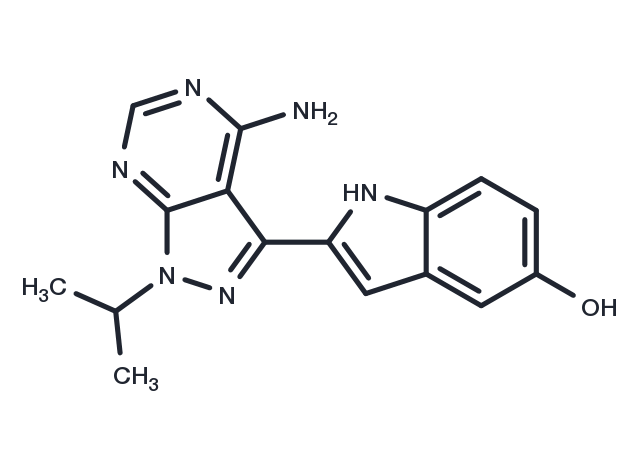Powder: -20°C for 3 years | In solvent: -80°C for 1 year


Torkinib (PP 242) (PP 242) is a selective and ATP-competitive mTOR inhibitor (IC50: 8 nM). It also inhibits mTORC1/2 (IC50s: 30/58 nM).

| Pack Size | Availability | Price/USD | Quantity |
|---|---|---|---|
| 5 mg | In stock | $ 52.00 | |
| 10 mg | In stock | $ 68.00 | |
| 25 mg | In stock | $ 97.00 | |
| 50 mg | In stock | $ 138.00 | |
| 100 mg | In stock | $ 239.00 | |
| 200 mg | In stock | $ 355.00 | |
| 500 mg | In stock | $ 589.00 | |
| 1 mL * 10 mM (in DMSO) | In stock | $ 57.00 |




| Description | Torkinib (PP 242) (PP 242) is a selective and ATP-competitive mTOR inhibitor (IC50: 8 nM). It also inhibits mTORC1/2 (IC50s: 30/58 nM). |
| Targets&IC50 | mTOR:8 nM (cell free), mTORC1:30 nM (cell free), mTORC2:58 nM (cell free), p110δ:0.10 μM (cell free) |
| In vitro | Torkinib (PP242) potently inhibited mTOR (IC50: 8 nM) but was much less active against other PI3-K family members. Testing of this compound against 219 protein kinases revealed remarkable selectivity relative to the protein kinome. In BT549 cells, PP242 inhibited the phosphorylation of Akt, the mTOR substrate p70S6K, and its downstream target S6 [1]. PP242 suppressed growth by > 90%, with low nanomolar potency (GI50: 12 nM). PP242 had greater anti-proliferative potency relative to rapamycin in a panel of solid tumor cell lines carrying either PI3K gain-of-function or PTEN loss-of-function [2]. |
| In vivo | In mouse p190 model, short-term oral dosing with PP242 in a dose-dependent manner significantly reduced leukemic burden in the spleen and bone marrow. In a long-term survival study, oral dosing of PP242 (30 and 60 mg/kg) significantly delayed the onset of leukemia [2]. In fat and liver, PP242 was able to completely inhibit the phosphorylation of Akt at S473 and T308. Surprisingly, PP242 was only partially able to inhibit the phosphorylation of Akt in skeletal muscle and was more effective at inhibiting the phosphorylation of T308 than S473, despite it's ability to fully inhibit the phosphorylation of 4EBP1 and S6 [3]. |
| Kinase Assay | Purified kinase domains were incubated with inhibitors at 2- or 4-fold dilutions over a concentration range of 50 - 0.001 μM or with vehicle (0.1% DMSO) in the presence of 10 μM ATP, 2.5 μCi of γ-32P-ATP and substrate. Reactions were terminated by spotting onto nitrocellulose or phosphocellulose membranes, depending on the substrate; this membrane was then washed 5–6 times to remove unbound radioactivity and dried. Transferred radioactivity was quantitated by phosphorimaging and IC50 values were calculated by fitting the data to a sigmoidal doseresponse using Prism software [1]. |
| Cell Research | Cells were seeded in triplicate wells of 96-well flat bottom culture plates for 48 hr in the presence of increasing concentrations of indicated inhibitors. Cell viability and median-effect dose affecting growth (GIC50) was determined using the MTS assay. Absorbance values (490 nm) were normalized to controls and expressed as %MTS conversion. Wells lacking cells but with MTS added was used as the zero value when normalizing. For drug combination experiments, a range of fixed ratios of inhibitors was used to assess synergy using the combination index (CI) with CalcuSyn software according to the median-effect method as previously described. For proliferation experiments with PC-3, SKOV3, 786-O, and U87 cells, the CellTiter-Glo Luminescent reagent was used following the manufacturer's instructions. Quantitation was performed as mentioned above [2]. |
| Animal Research | Drugs were prepared in 100 μl of vehicle containing 20% DMSO, 40% PEG-400, and 40% saline. Six-wk-old male C57BL/6 mice were fasted overnight prior to drug treatment. PP242 (0.4 mg), rapamycin (0.1 mg), or vehicle alone was injected IP. After 30 min for the rapamycin-treated mouse or 10 min for the PP242 and vehicle-treated mice, 250 mU of insulin in 100 μl of saline was injected IP. 15 min after the insulin injection, the mice were killed by CO2 asphyxiation followed by cervical dislocation. Tissues were harvested and frozen on liquid nitrogen in 200 μl of cap lysis buffer. The frozen tissue was thawed on ice, manually disrupted with a mortar and pestle, and then further processed with a micro tissue-homogenizer. The protein concentration of the cleared lysate was measured by Bradford assay and 5–10 μg of protein was analyzed by Western blot as described above [3]. |
| Synonyms | PP 242 |
| Molecular Weight | 308.34 |
| Formula | C16H16N6O |
| CAS No. | 1092351-67-1 |
Powder: -20°C for 3 years | In solvent: -80°C for 1 year
DMSO: 7.7 mg/mL (25 mM)
You can also refer to dose conversion for different animals. More
bottom
Please see Inhibitor Handling Instructions for more frequently ask questions. Topics include: how to prepare stock solutions, how to store products, and cautions on cell-based assays & animal experiments, etc.
Torkinib 1092351-67-1 Apoptosis Autophagy PI3K/Akt/mTOR signaling Mitophagy PI3K mTOR Mammalian target of Rapamycin PP-242 PP242 inhibit Mitochondrial Autophagy PP 242 Inhibitor inhibitor
